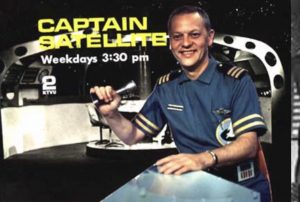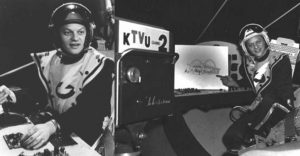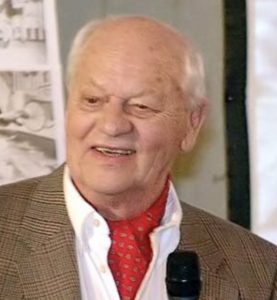By Kevin Wing
Senior Correspondent, Off Camera
 Bob March, forever immortalized throughout the San Francisco Bay Area and northern California as “Captain Satellite”, early local television’s Space Age hero to a generation of Baby Boomers, has died.
Bob March, forever immortalized throughout the San Francisco Bay Area and northern California as “Captain Satellite”, early local television’s Space Age hero to a generation of Baby Boomers, has died.
March was 93 when he died Aug. 6 at a hospital near his home in the Placer County community of Loomis.
A 1990 inductee of the Silver Circle of the San Francisco/Northern California Chapter of The National Academy of Television Arts & Sciences, March was one of the Bay Area’s first pioneering television stars, hosting the Captain Satellite children’s show on KTVU Channel 2 from 1958 to 1969. The show debuted the week after the station first signed on the air, in March 1958.
As Captain Satellite, March appeared on screen in his space suit with a bubble helmet, sitting inside his spaceship. With children appearing on his show as “space pals” accompanying March on a spaceship ride into astral space, he would introduce cartoons and other segments geared toward his young after-school audience weekday afternoons at 3:30 p.m.
 To the tens of thousands of children who watched Captain Satellite each weekday afternoon after school on KTVU, the popular afternoon kiddie show was the welcoming answer for kids of all ages after a long day at school.
To the tens of thousands of children who watched Captain Satellite each weekday afternoon after school on KTVU, the popular afternoon kiddie show was the welcoming answer for kids of all ages after a long day at school.
By the time March arrived at KTVU, he had already become a broadcasting veteran.
Born Robert William Monkman in Racine, Wisconsin, he was immediately drafted into the Army right out of high school. He knew that when he got out, he wanted to pursue his dream of being on the radio. Eventually, he would decide to adopt Bob March as his stage name.
 By 1947, at age 20, March got his big break. He was hired by WRJN radio in Racine. Working as a radio announcer there for several years, March eventually started setting his sights on the new medium of television.
By 1947, at age 20, March got his big break. He was hired by WRJN radio in Racine. Working as a radio announcer there for several years, March eventually started setting his sights on the new medium of television.
“I got to thinking at the time that this thing called TV could catch on,” March said, in an Off Camera interview with this reporter in August 2019.
In 1954, Milwaukee’s CBS station, WXIX, hired him to produce and star in a children’s television show. March remained at the station for 18 months. During that time, the station, which was on the UHF dial at Channel 19 and had a terrible signal, began giving away free antennas so television viewers could watch the station with clarity from their living rooms.
 A year and a half after he began at WXIX, a friend suggested to March that he head west to California to find out what his next chapter in television would be. So, he left Wisconsin and headed for the Golden State.
A year and a half after he began at WXIX, a friend suggested to March that he head west to California to find out what his next chapter in television would be. So, he left Wisconsin and headed for the Golden State.
He wound up in Bakersfield.
He worked as an on-camera performer and also directed various programs at a new station in the southern San Joaquin Valley city. The year was 1956. March would remain there until 1957.
It was around that time that March got wind of a new independent TV station getting ready to launch itself in the Bay Area to compete against the three network stations in San Francisco. That station was KTVU Channel 2 in Oakland.
March got in touch with the station and eventually met with Bill Pabst, the station’s original owner. Pabst told March what he could do for the station: create a children’s show based around a character named Captain Satellite, an idea spurred by March’s interest in space exploration and inspired by, in part, his childhood hero, Charles Lindbergh.
“I had it all well-organized,” March explained. “I had the whole show drawn out. I knew what I wanted the costumes to look like, the whole thing.”
Pabst was sold on the idea, and March became one of KTVU’s first employees, starting there a week after the station went on the air. And so, in the spring of 1958, Captain Satellite debuted on KTVU, airing live for one hour every weekday afternoon.
The show became a smash hit with Bay Area children. March’s signature outfit on the air was a helmet and a dark uniform under a light-colored triangular vest, with artwork featuring a thunderbolt passing through a globe. The show’s set was a cutaway rocket ship called the Starfinder II (“two,” for Channel 2) which blasted off each afternoon.
“For the show’s entire run, we were on live, every day, from 3:30 to 4:30 in the afternoon, five days a week. There was no tape then. We did it live, all live,” March said, in August 2019.
To make the Captain Satellite show even more interesting, March established a working relationship with NASA Ames Research Center in Mountain View. From that union, NASA space footage would be sent periodically to March to feature on his show. The show also featured local children who would serve as March’s co-hosts every day. With them aboard the spaceship, the Starfinder II would orbit on auto-pilot, and the children would participate in games to win prizes.
The show introduced cartoons. Occasionally, there would be special appearances, such as when The Three Stooges came to visit the Starfinder II. Also, the original seven Mercury astronauts made appearances on the program.
After the show ended just before the beginning of the 1970s, March continued on at the station for another five years, working as an announcer, and directing Nancy Besst as Miss Nancy on Romper Room. He also hosted the station’s Dialing for Dollars for a short time in the early 1970s. Finally, it was time for March to say goodbye to KTVU, and embark on a new chapter in his career. The station was phasing out the kiddie programs.
He taught broadcasting at San Francisco State; then in 1973, March earned his master’s degree in counseling, going to work in marriage and family counseling for several years.
March and his wife, Alice, celebrated their 52nd wedding anniversary last August. They met in the 1960s when they were both cast in a play in the Bay Area.
The couple lived in Berkeley and Pleasant Hill for many years, then in the 1990s, they moved to the Folsom area, and later, Placerville. For the last three years, they had been living in Loomis.
Their home is filled with mementos of March’s television career, including a framed photograph of him posing with The Three Stooges in the 1960s and a colored caricature of March in the 1970s. He also has a scrapbook that details his life: old photographs of his family, KTVU memorabilia, and a photograph of him with Clint Eastwood. March had a small role in Eastwood’s 1973 action thriller movie, Magnum Force.
 In last year’s interview for Off Camera, March looked back at his colorful career. He said he had the time of his life.
In last year’s interview for Off Camera, March looked back at his colorful career. He said he had the time of his life.
“It was a lot of fun,” he said. “I spent half my life in front of a television camera. It was all so much fun.”
During last year’s interview, this reporter showed YouTube clips of Captain Satellite from the 1960s to March. He had not seen himself on TV in years. He loved every moment of watching himself again, all those years later.
March is survived by his wife, Alice March of Loomis. He is also survived by sons Robin March of Antioch and Brian March of Oakland, and three stepchildren.
A memorial service is pending.









